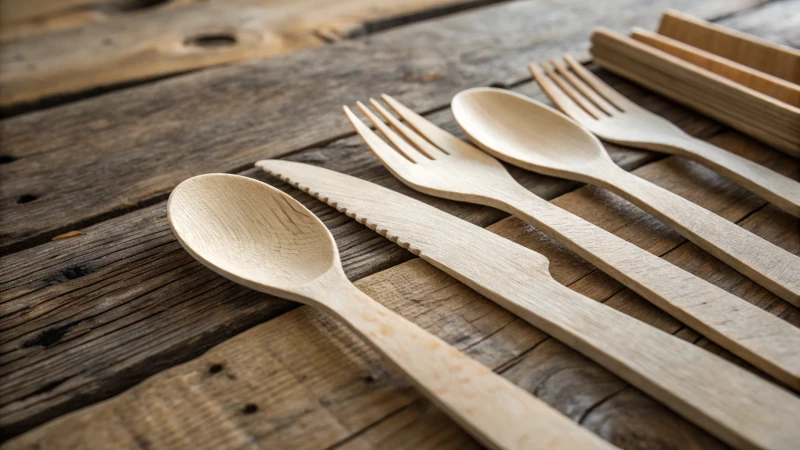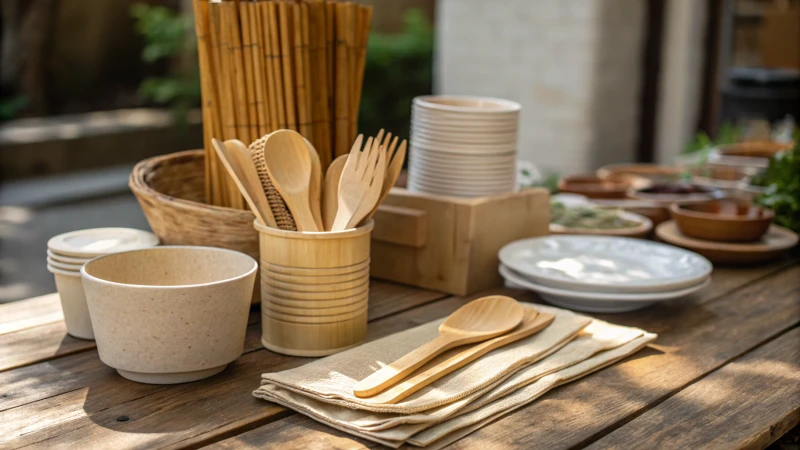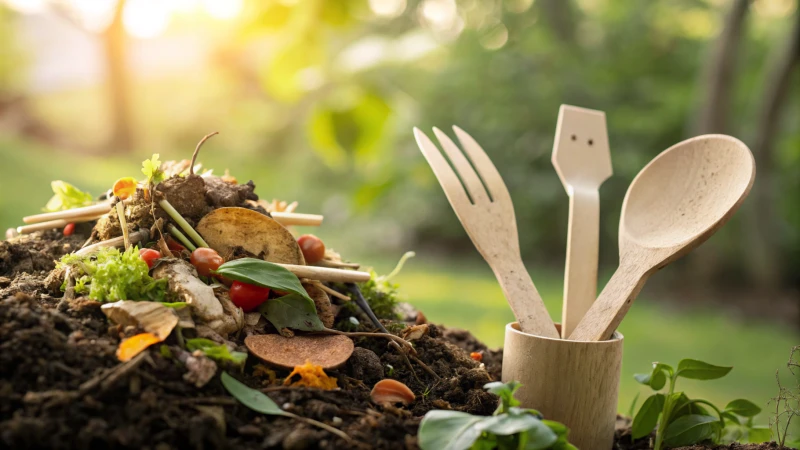
Have you ever wondered if your choice of wooden cutlery truly supports a greener planet?
Yes, disposable wooden cutlery is biodegradable. The time it takes to decompose varies depending on the wood type and environmental conditions, typically ranging from a few months to several years.
Understanding how wooden cutlery breaks down can really help in making eco-friendly decisions. I remember when I first swapped out plastic for wood at a family barbecue—it felt like a step towards positive change. Let’s explore what affects its biodegradability and see how it compares to other materials.
Disposable wooden cutlery decomposes in less than a year.False
Decomposition time varies, often taking from months to several years.
Wooden cutlery is more biodegradable than plastic.True
Wooden cutlery breaks down naturally, unlike most plastics.
What Factors Affect the Decomposition Time of Wooden Cutlery?
Ever wondered what happens to wooden cutlery after a picnic?
The decomposition time of wooden cutlery hinges on factors such as the wood type, environmental conditions like temperature and humidity, and whether the wood has been chemically treated or coated.

I remember one particularly sunny afternoon, hosting a family picnic, when my environmentally conscious sister brought along wooden cutlery instead of the usual plastic forks and spoons. She went on and on about how they'd decompose faster and were better for the planet. But as we packed up, I couldn't help but wonder: just how long would they actually take to break down?
Types of Wood and Their Impact
This question led me down a rabbit hole of discovery about wooden cutlery. It turns out, the type of wood really matters. Take oak, for instance—it's a hardwood with a dense cellular structure. This makes it sturdy but also a bit stubborn when it comes to breaking down. It's like that friend who never leaves a party early! On the other hand, softer woods like birch are the life of the compost pile, decomposing much quicker.
The type of wood used in manufacturing cutlery significantly influences its decomposition rate. Hardwoods like oak take longer to decompose compared to softer woods like birch due to their denser cellular structure, which makes them more resistant to environmental1 breakdown.
Environmental Conditions
Another eye-opener was how much the environment affects decomposition. Imagine trying to throw a summer BBQ in the middle of winter—things just don't happen as fast! Similarly, in warm and humid climates, microorganisms are like little helpers, speeding up the process. However, if it's too dry or cold, decomposition takes its sweet time. It's like trying to defrost chicken in the fridge instead of the microwave.
Environmental conditions such as temperature, humidity, and soil quality are crucial:
| Condition | Effect on Decomposition |
|---|---|
| High Temperature | Speeds up |
| High Humidity | Speeds up |
| Cold Climate | Slows down |
| Dry Environment | Slows down |
Proper disposal in composting facilities can enhance decomposition by maintaining optimal conditions.
Chemical Treatments and Coatings
And then there's the issue of chemical treatments. My sister's cutlery was all-natural, but not all wooden utensils are. Some are treated with chemicals for durability or looks, which can slow decomposition. It's like wrapping a gift with so much tape that no one can open it!
Chemical treatments used to enhance durability or aesthetics can impede decomposition. For instance, varnishes and coatings create a barrier against moisture and microorganisms, slowing down natural decay processes. It's crucial to verify if the cutlery is free from such treatments when assessing its biodegradability.
Processing Techniques
The way wood is processed also makes a difference. Manufacturers focused on sustainability often choose less intensive methods to help their products break down more easily. It's kind of like opting for fresh veggies over canned—one's just more natural.
How wood is processed before becoming cutlery also matters; processes that compress or densify wood can impact its ability to decompose efficiently.
Impact of Soil Microorganisms2
Finally, I learned that the soil itself plays a role. Rich organic soil is teeming with microorganisms eager to break down our wooden friends. Composting facilities are perfect for this environment that's ideal for decomposition.
The presence of active microorganisms in soil is essential for decomposition; rich organic soils allow these organisms to break down wooden cutlery faster than sterile or heavily polluted soils.
Understanding these factors really opened my eyes to making more informed choices about wooden cutlery and its place in our eco-friendly future.
Hardwoods decompose faster than softwoods.False
Softwoods decompose faster due to their less dense cellular structure.
High humidity accelerates decomposition of wood.True
Moisture supports microorganism growth, speeding up the breakdown process.
How Does Wooden Cutlery Compare to Other Biodegradable Utensils?
Ever wondered if wooden cutlery is truly the eco-friendly hero it claims to be? Join me as I dig into its strengths and see how it measures up against bamboo and cornstarch alternatives.
Wooden cutlery shines with its blend of strength, comfort, and natural beauty, outperforming other biodegradable options like bamboo and cornstarch. It breaks down quickly in compost, making it a standout choice for sustainable dining.

Durability and Usability
I've always been one for impromptu picnics, and wooden cutlery has been a trusty companion. It's surprisingly sturdy—no embarrassing breakages when cutting through that tough steak at a barbecue! Bamboo is equally strong but feels a bit like holding onto a ruler, which isn't as comfy.
Table 1: Comparison of Durability
| Material | Durability | Comfort |
|---|---|---|
| Wood | High | Comfortable |
| Bamboo | High | Less Comfortable |
| Cornstarch | Moderate | Comfortable |
Environmental Impact
One of my proudest moments was switching from plastic to wooden cutlery. It's crafted from renewable woods like birch or maple, so I feel good knowing it's kinder to our planet. It composts in months—far quicker than you'd imagine, though bamboo lingers longer due to its heft.
Cornstarch-based utensils vanish quickly too but need industrial composting sites, not always around the corner. This can curb their green potential.
Wooden cutlery is typically made from renewable sources like birch or maple, ensuring a lower carbon footprint3 compared to plastic.
Aesthetic Appeal
At one of my friend's weddings, the rustic charm of wooden cutlery stole the show. Those intricate grain patterns were the talk of the night—plastic or cornstarch just can't compete. Bamboo looks nice too but lacks that unique flair.
For those keen on a sustainable image4, wood offers an edge with its personal touch.
Cost Effectiveness
Admittedly, wooden cutlery can pinch the wallet more than plastic, but it levels out with other biodegradable options. Prices fluctuate based on wood type and design needs. Yet, with demand soaring, costs are bound to drop, rivaling cornstarch and bamboo.
For procurement pros like Ahmed or Sarah, these cost trends are crucial in shaping smart buying choices.
Table 2: Cost Comparison
| Material | Average Cost per Unit |
|---|---|
| Wood | $0.10 |
| Bamboo | $0.12 |
| Cornstarch | $0.08 |
Health and Safety Considerations
Safety is non-negotiable for me—wood and bamboo cutlery usually skip harsh chemicals, making them safer for food. Some cornstarch options might sneak in additives.
Wood's natural antibacterial traits are another bonus, keeping hygiene top-notch in any dining scenario.
Explore how wooden cutlery aligns with health standards5 crucial for sectors like healthcare or luxury hospitality.
in summary while all biodegradable utensils are strides ahead of plastics in eco-friendliness wooden cutlery shines for its durability looks and biodegradability it's perfect for businesses aiming to uphold both green goals and quality.
Wooden cutlery is more durable than cornstarch utensils.True
Wooden cutlery can handle tougher foods without breaking, unlike cornstarch.
Bamboo decomposes faster than wooden cutlery.False
Bamboo takes longer to decompose due to its density compared to wood.
Can All Types of Wooden Cutlery Be Composted at Home?
Ever wondered if that wooden fork you used at last night’s dinner party can be composted right at home?
Yes, most wooden cutlery can be composted at home, as long as it's untreated and free from coatings. However, the decomposition rate depends on the type of wood and your composting conditions.

Understanding Wooden Cutlery Materials
When I first started my journey into sustainable living, I was surprised to learn how different types of wood affect composting. Wooden cutlery typically comes from birch, bamboo, or pine. Each has its quirks. Birch is like the eager student in class, decomposing quickly because it's a softwood. Bamboo, on the other hand, is the strong silent type—hardwood that takes its time to break down. Bamboo cutlery6 requires a bit more patience in your compost pile.
| Type | Decomposition Time | Notes |
|---|---|---|
| Birch | 3-6 months | Softwood, faster decomposition |
| Bamboo | 6-12 months | Hardwood, requires longer time |
| Pine | 4-8 months | Softwood, moderate decomposition time |
Coatings and Treatments
Not all wooden cutlery is created equal. Some pieces come with glossy coatings or finishes that slow decomposition. Think of it as wearing a raincoat during a storm—it keeps things from getting through. I always make sure my cutlery is untreated or naturally polished to ensure it can become part of my garden without any issues.
Ideal Composting Conditions
I’ve learned that for the best breakdown results, wooden cutlery should join the party in a hot compost pile with a good mix of greens and browns. This combination invites the microbial life needed to speed up decomposition.
Environmental Impact
Composting wooden cutlery at home helps reduce landfill waste and supports a circular economy. It’s my little contribution to a bigger cause, and understanding the benefits of composting7 has reinforced its importance in my sustainable living efforts.
Challenges and Considerations
Admittedly, not every piece breaks down as easily in home compost due to varying conditions. Sometimes I think about industrial composting facilities—they're like the big leagues designed to handle these variances more effectively. Always check your local composting guidelines and facilities; they’re often more equipped than we are in our backyards.
For more insights on sustainable waste management, check out sustainable practices8 that might align with your lifestyle goals and environmental commitments. Sharing these practices can inspire others to join the sustainability movement.
Birch cutlery decomposes faster than bamboo in compost.True
Birch is a softwood, decomposing in 3-6 months, faster than bamboo.
All wooden cutlery can be composted at home without issues.False
Coatings and treatments on some cutlery can hinder decomposition.
Why Choose Wooden Cutlery for a Greener Planet?
Did you ever imagine your humble fork could help save the planet?
Wooden cutlery is an eco-friendly choice because it naturally decomposes without leaving harmful residues, unlike plastic, which lingers for centuries. Made from renewable sources, it offers a sustainable way to reduce waste and pollution.

Biodegradability and Compostability
Switching to wooden cutlery is like choosing to carry an umbrella on a drizzly day—it just makes sense when you're looking to protect the environment. I remember the first time I used wooden utensils at a picnic. It felt like a small step towards something big—a sustainable future. Wooden cutlery, crafted from birch, bamboo, or spruce, is a testament to nature's efficiency, breaking down in mere months if treated right.
| Material | Decomposition Time |
|---|---|
| Birch | 3-6 months |
| Bamboo | 4-6 months |
| Plastic | Up to 1,000 years |
Consider this: while your trusty wooden fork takes a graceful bow in about 3-6 months (depending on its wood type), its plastic counterpart stubbornly sticks around for up to a millennium. Imagine the relief of knowing that your choice helps prevent microplastics from leaching into our precious ecosystems.
Sourcing from Renewable Resources
I once met a supplier who passionately explained how their wooden cutlery was sourced. They painted a picture of lush forests managed by teams dedicated to sustainable practices. These aren't just tales spun for brochures—companies often plant more trees than they harvest, creating a cycle of renewal. Bamboo, for instance, grows like wildfire without needing harmful pesticides or fertilizers. It’s like nature’s generous gift that keeps on giving, fostering a cycle that benefits us all. Learn more about bamboo's sustainability9 advantages.
Reduction in Carbon Footprint
The energy used to produce wooden cutlery is significantly lower than what goes into plastic production. I’ve seen firsthand how the simple act of cutting and shaping wood is less energy-hungry than the intense processes needed for plastic molding. Plus, during its life, wood acts as a carbon sink, soaking up CO2 like a sponge until it naturally decomposes. This not only offsets emissions during production but also during transport—helping us breathe easier.
Supporting Local Economies and Practices
Choosing wooden cutlery isn't just about being kind to the Earth; it's also about supporting those who cultivate it responsibly. By opting for these eco-friendly options, we back local economies rooted in sustainable forestry. I’ve visited places where communities thrive on fair practices and ethical wages, and the impact of our choices becomes palpably clear.
By bringing wooden cutlery into our lives, we’re not just setting the table for a meal—we’re setting the stage for a sustainable legacy. It’s about supporting biodiversity, reducing waste, and making pollution a thing of the past.
Wooden cutlery decomposes faster than plastic utensils.True
Wooden cutlery decomposes in months, while plastic can take up to 1,000 years.
Plastic utensils are more sustainable than wooden cutlery.False
Plastic takes longer to decompose and releases microplastics, unlike wood.
Conclusion
Disposable wooden cutlery is biodegradable, decomposing in months to years based on wood type and conditions. It outperforms plastic, making it a sustainable choice for eco-conscious consumers.
-
Explore the link to learn how different types of wood influence biodegradability and why some woods decompose faster than others. ↩
-
Find out how soil microorganisms contribute to the breakdown of biodegradable materials like wooden cutlery in composting environments. ↩
-
Discover how wooden cutlery reduces carbon emissions compared to plastic, highlighting its environmental benefits. ↩
-
Learn how using wooden utensils can enhance your brand's sustainability image, attracting eco-conscious customers. ↩
-
Find out why wooden cutlery meets stringent health standards, ensuring safe use in food service applications. ↩
-
Discover how bamboo's durability affects its compostability and tips for effective breakdown in home compost systems. ↩
-
Learn how composting at home contributes to waste reduction and enhances soil fertility. ↩
-
Find strategies to improve your waste management approach and support eco-friendly initiatives. ↩
-
Discovering bamboo's rapid growth and minimal resource requirements emphasizes its eco-friendly nature. ↩

